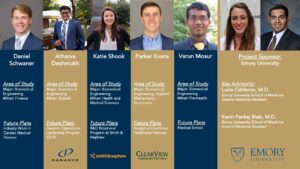According to Cleveland Clinic, “Achalasia develops in about 1 in every 100,000 people in the U.S. each year. It is typically diagnosed in adults between the ages of 25 and 60, but can occur in children as well (less than 5% of cases are in children under age 16).”
The cause is unknown, there is no cure and current therapies require repetitive interventions, are poorly tolerated by patients and are expensive. The most radical, esophagectomy, costs $115,000 and is highly invasive.
What is Achalasia?
“Imagine sitting at a dinner table surrounded by all of your favorite foods, but you’re unable to eat any of it. This is often the reality for many people living with Achalasia, a rare condition where damaged nerves surrounding the esophagus and impaired relaxation of the lower esophageal sphincter prevents effective movement of food, liquids, saliva, etc. into the stomach. The G.I. (Mostly) Joes are addressing the dysmotility of the esophagus in order to improve eating, symptom management, and overall quality of life for patients living with this condition.”
So wrote the Spring 2021 Georgia Tech Capstone Team GI Mostly Joes.
As their Spring 2021 Capstone Project, a group of students from the Georgia Tech School of Biomedical Engineering brought forth an esophageal contractile ring in an attempt to restore swallowing in Achalasia patients through magnetic contraction. The challenge was brought forth by an unmet clinical need in critical care via Drs. Lucie Calderon (Resident, Internal Medicine, Emory University) and Kevin Pankaj Shah (Interventional Radiology Specialist, Emory University).
The team performed in-lab cadaveric and silicon modeled bench-top validation testing of their Capstone Project’s technology with the help of GCMI and our preclinical arm, T3 Labs.
“When you hear people who suffer from Achalasia describe just how debilitating it is and how much their quality of life suffers, it is a highly motivating factor to try and help find a solution,” said team member Katie Shook.
“We needed to validate whether or not our device could create the appropriate pressures needed to restore esophageal function in tissue that closely mimics live human tissue,” Katie continued. “We also needed to do this in a safe environment for live tissue where sanitation would not be a concern. The GCMI and T3 Labs team helped prepare the space, tools, and specimen we needed for the validation testing event.”
As is often the result in verification testing, things didn’t go as planned.
“We didn’t get the results or data we were expecting in cadaveric testing,” Katie said. “We believe that is because the atmospheric conditions in cadavers are significantly different from those in a live animal. So we set about to create a silicone model with the help of the GCMI team and its 3D printing capabilities.”
The team tested its technology on the newly created model on April 22nd. They discovered their device surpassed the average contractile pressure normally present in peristalsis which indicated promising results. They were also able to use the silicone mold to validate their sensor which had over a 95% accuracy in detecting the passage of varying sized boluses and initiating a response.
While the team has filed a provisional patent application, their technology would almost certainly come to life as an FDA Class III device. According to the U.S. Food and Drug Administration, devices in this classification usually sustain or support life, are implanted, or present potential unreasonable risk of illness or injury. The design and development pathway for these devices involves many years and many, many millions of dollars.
“We won’t know precisely what’s next without additional testing and data,” Katie said. “But we’ve created a solid foundation from which we can make a well educated decision on what’s next for our technology’s pathway.”
We applaud G.I. (Mostly) Joes for their important work, and wish them all great success in their future endeavors.

GCMI’s mission is to bring new medical technologies to market that improve quality-based outcomes and delivery of care for patients worldwide. This certainly includes supporting development of medical technologies born in our backyard from faculty, researchers and students with whom we share our institutional affiliation. We congratulate the Spring 2021 teams and eagerly anticipate what the Fall teams have to show us later this year.
